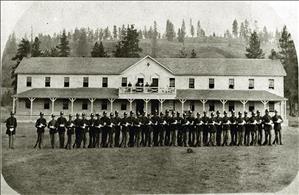On April 7, 1826, Spokane House, which was built in 1810 by the North West Company of Montreal, is officially closed. The first trade house constructed in what will later become the state of Washington, the post is located at the confluence of the Spokane and Little Spokane rivers, about a dozen miles northwest of the present-day city of Spokane. After serving for 16 years as the headquarters for fur traders in present-day British Columbia, Eastern Washington, Idaho, and Western Montana, the post is being replaced by the new Fort Colvile, which is more conveniently situated at Kettle Falls on the main stem of the Columbia River.
Putting It on the Map
In the summer of 1810, Jacques Raphael ("Jaco") Finlay (1768-1828) followed a tribal trail from Lake Pend Oreille down the Spokane River. A North West Company clerk and scout, Finlay was instrumental in helping geographer and fur agent David Thompson (1770-1857) expand the Canadian fur trade west of the Rockies. According to tribal history, a group of Spokane Indians guided Finlay to one of their villages at the junction of the Spokane and Little Spokane rivers. Situated near rich salmon and steelhead fisheries where peoples from around the region gathered to fish and trade, the location seemed ideal for a fur post. Here, on a large flat covered with ponderosa pines, Finlay and his crew erected a small trade house.
Spokane House entered written history on June 14, 1811, when David Thompson arrived with a fresh supply of trade goods. The next day, taking advantage of fine weather, Thompson calculated the post's latitude as 47 degrees 47' 4" N and its longitude as 117 degrees 27' 11" W. Today's geographers plot its coordinates as 47 degrees 47' 16" N and 117 degrees 31' 52" W. After retiring to Eastern Canada in 1812, Thompson used his meticulous observations to render the first accurate map of the Columbia drainage. Spokane House was clearly labeled, as were a series of dotted lines representing the network of tribal trails that led from the Spokane confluence north and west to the Columbia, south to the Snake River, and northeast to Lake Pend Oreille.
During the next 13 years, the British-owned North West Company and Hudson's Bay Company and American John Jacob Astor's Pacific Fur Company all operated trade posts on the site at various times. By 1822, a sizeable compound operated by the Hudson's Bay Company included a trade store, chief trader's house, barracks, blacksmith shop, and stable. As the headquarters and depot for traders in what is now British Columbia, Western Montana, Northern Idaho, and Eastern Washington, as well as those undertaking expeditions up the Snake River, Spokane House played a key role in the economic and social development of the Inland Northwest.
Moving the Bottom Line
In early April 1825, George Simpson (ca. 1787-1860), governor of the Hudson's Bay Company's Columbia Department, conferred with Chief Trader James McMillan (1783-1858) and two clerks from Spokane House about its future. Three years earlier, Chief Factor Alexander Kennedy (ca. 1781-1832) had suggested transferring operations to a new post at Kettle Falls, some 70 miles north on the Columbia, in view of several disadvantages with the Spokane location. His main complaint was that the Spokane River was not navigable for loaded canoes during much of the year, so that horses either had to be purchased and maintained, or rented from the Spokanes in order to carry furs and goods between the Columbia and the post. This overland transport required much more time and manpower than did travel by canoe. In addition, Kennedy maintained that Kettle Falls possessed richer soil for farming and more prolific salmon fisheries, which would further reduce operating costs.
A stickler for economy, Simpson agreed that the Spokane post should be closed and replaced with a new trade house near Kettle Falls on the main stem of the Columbia. He wrote that as "[u]nder all circumstances it appears that the change will be attended with advantage[,] it is therefore resolved upon" (Simpson, 135). The only difficulty that he foresaw in abandoning Spokane House was that "it may give offence to the Spokan Indians who have always been staunch to the Whites" (Simpson, 135).
Almost a year later, on March 21, 1826, agent John Work (ca. 1792-1861) reported: "The blacksmith & cook, the only two men we have now here, employed collecting all the iron about the place, stripping hinges off door &c. The Indians much regret our going off" (Work, 5). Despite their unhappiness with the post's closure, the local tribespeople assisted with the transfer to Kettle Falls by pressing fur packs, renting dozens of horses to carry pelts and supplies, shuttling packhorses to and from the mouth of the Spokane, and performing various other duties. At noon on April 7, John Work departed with 59 horses loaded with the last property from the post.
But Spokane House was not completely abandoned. Jaco Finlay, who had built the first small post 16 years earlier, continued to live in the compound with his family until his death in 1828.

